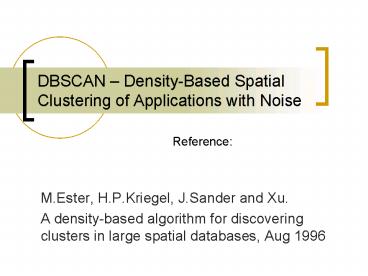DBSCAN PowerPoint PPT Presentation
1 / 15
Title: DBSCAN
1
DBSCAN Density-Based Spatial Clustering of
Applications with Noise
Reference
- M.Ester, H.P.Kriegel, J.Sander and Xu.
- A density-based algorithm for discovering
clusters in large spatial databases, Aug 1996
2
DBSCAN
- Density-based Clustering locates regions of high
density that are separated from one another by
regions of low density. - Density number of points within a specified
radius (Eps) - DBSCAN is a density-based algorithm.
- A point is a core point if it has more than a
specified number of points (MinPts) within Eps - These are points that are at the interior of a
cluster - A border point has fewer than MinPts within Eps,
but is in the neighborhood of a core point
3
DBSCAN
- A noise point is any point that is not a core
point or a border point. - Any two core points are close enough within a
distance Eps of one another are put in the same
cluster - Any border point that is close enough to a core
point is put in the same cluster as the core
point - Noise points are discarded
4
Border Core
Outlier
Border
? 1unit MinPts 5
Core
5
Concepts e-Neighborhood
- e-Neighborhood - Objects within a radius of e
from an object. (epsilon-neighborhood) - Core objects - e-Neighborhood of an object
contains at least MinPts of objects
e-Neighborhood of p
e
e
e-Neighborhood of q
p
q
p is a core object (MinPts 4) q is not a core
object
6
Concepts Reachability
- Directly density-reachable
- An object q is directly density-reachable from
object p if q is within the e-Neighborhood of p
and p is a core object.
- q is directly density-reachable from p
- p is not directly density- reachable from q?
e
e
p
q
7
Concepts Reachability
- Density-reachable
- An object p is density-reachable from q w.r.t e
and MinPts if there is a chain of objects
p1,,pn, with p1q, pnp such that pi1is
directly density-reachable from pi w.r.t e and
MinPts for all 1 lt i lt n
- q is density-reachable from p
- p is not density- reachable from q?
- Transitive closure of direct density-Reachability,
asymmetric
q
p
8
Concepts Connectivity
- Density-connectivity
- Object p is density-connected to object q w.r.t e
and MinPts if there is an object o such that both
p and q are density-reachable from o w.r.t e and
MinPts
- P and q are density-connected to each other by r
- Density-connectivity is symmetric
q
p
r
9
Concepts cluster noise
- Cluster a cluster C in a set of objects D w.r.t
e and MinPts is a non empty subset of D
satisfying - Maximality For all p, q if p Î C and if q is
density-reachable from p w.r.t e and MinPts, then
also q Î C. - Connectivity for all p, q Î C, p is
density-connected to q w.r.t e and MinPts in D. - Note cluster contains core objects as well as
border objects - Noise objects which are not directly
density-reachable from at least one core object.
10
(Indirectly) Density-reachable
p
p1
q
Density-connected
p
q
o
11
DBSCAN The Algorithm
- select a point p
- Retrieve all points density-reachable from p wrt
? and MinPts. - If p is a core point, a cluster is formed.
- If p is a border point, no points are
density-reachable from p and DBSCAN visits the
next point of the database. - Continue the process until all of the points have
been processed. - Result is independent of the order of processing
the points
12
An Example
MinPts 4
13
DBSCAN Determining EPS and MinPts
- Idea is that for points in a cluster, their kth
nearest neighbors are at roughly the same
distance - Noise points have the kth nearest neighbor at
farther distance - So, plot sorted distance of every point to its
kth nearest neighbor
14
DBSCAN Determining EPS and MinPts
- Distance from a point to its kth nearest
neighborgtk-dist - For points that belong to some clusters, the
value of k-dist will be small if k is not larger
than cluster size - For points that are not in a cluster such as
noise points, the k-dist will be relatively large - Compute k-dist for all points for some k
- Sort them in increasing order and plot sorted
values - A sharp change at the value of k-dist that
corresponds to suitable value of eps and the
value of k as MinPts
15
DBSCAN Determining EPS and MinPts
- A sharp change at the value of k-dist that
corresponds to suitable value of eps and the
value of k as MinPts - Points for which k-dist is less than eps will be
labeled as core points while other points will be
labeled as noise or border points. - If k is too largegt small clusters (of size less
than k) are likely to be labeled as noise - If k is too smallgt Even a small number of
closely spaced that are noise or outliers will be
incorrectly labeled as clusters

